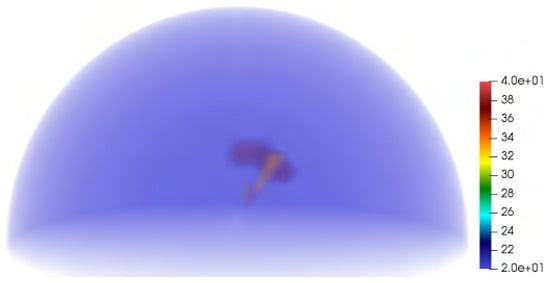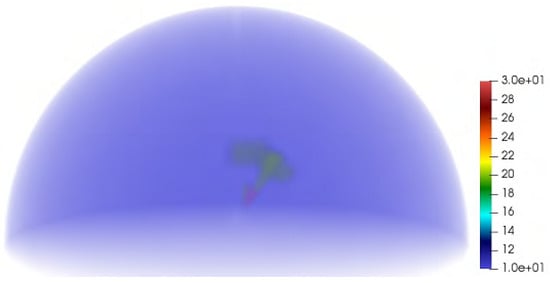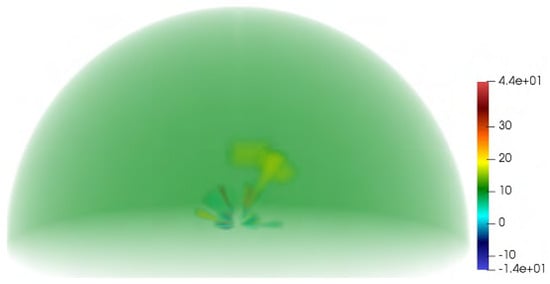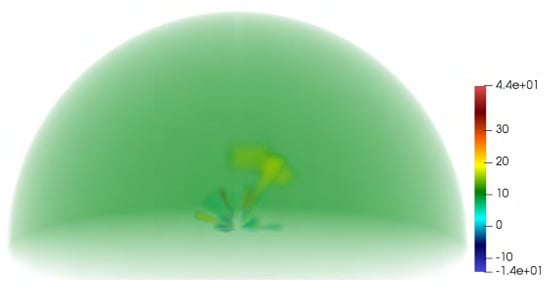Abstract
This work is devoted to the development and implementation of a two-step method for solving the vector three-dimensional inverse diffraction problem on an inhomogeneous dielectric scatterer having the form of a hemisphere characterized by piecewise constant permittivity. The original boundary value problem for Maxwell’s equations is reduced to a system of integro-differential equations. An integral formulation of the vector inverse diffraction problem is proposed and the uniqueness of the solution of the first-kind integro-differential equation in special function classes is established. A two-step method for solving the vector inverse diffraction problem on the hemisphere is developed. Unlike traditional approaches, the two-step method for solving the inverse problem is non-iterative and does not require knowledge of the exact initial approximation. Consequently, there are no issues related to the convergence of the numerical method. The results of calculations of approximate solutions to the inverse problem are presented. It is shown that the two-step method is an efficient approach to solving vector problems in near-field tomography.
1. Introduction
Inverse vector diffraction problems of electromagnetic waves in three-dimensional space are of great interest in medical diagnostics, non-destructive testing, and defectoscopy [,,]. One of the most common approaches to solving these problems involves minimizing certain error functionals using Tikhonov regularization and iterative methods that require the selection of a good initial approximation [,,,].
This paper discusses a non-iterative approach to solving the three-dimensional vector inverse problem of reconstructing the inhomogeneity of a dielectric body in the form of a hemisphere based on near-field electromagnetic measurements. It is necessary to find the unknown piecewise continuous permittivity (or corresponding refractive index) of a bounded scatterer in , a hemisphere.
Unlike traditional approaches, the two-step method for solving the inverse problem is non-iterative, and therefore, does not require selecting a good initial approximation. This advantage of the two-step method is crucial because the selection of a good initial approximation in iterative methods is a separate and challenging task. Additionally, there are no issues related to the convergence of the numerical method. In many approaches to solving inverse problems, the convergence of iterative methods is not rigorously proven and estimates of convergence rates are not obtained. In contrast, the two-step non-iterative method that we develop allows us to directly solve the system of linear algebraic equations that arises when solving the inverse problem using well-known methods. The main drawback of our method is poor conditioning of the matrix of the linear algebraic equation system. However, this is not a drawback of the method itself; in fact, it is a property of inverse problems in general. On the other hand, the solution techniques of such systems of linear algebraic equations are well developed at present. In our case, standard regularization methods and the construction of preconditioners have proven to be efficient.
The paper describes, justifies, and applies a two-step method that has been successfully used previously to solve other scalar and vector inverse scattering problems [,,,,].
The article consists of four sections.
In the first section, the direct problem of diffraction of a monochromatic electromagnetic wave by a bounded scatterer with a given constant permeability of vacuum and variable permittivity of the scatterer is formulated. The initial boundary problem for Maxwell’s equations is reduced to a system consisting of a singular integro-differential equation for the electric field in the inhomogeneity domain and an integral representation of the total electric field outside the scatterer. The main results concerning the solvability of the direct diffraction problem are presented.
The second section is devoted to the theoretical study of the inverse diffraction problem, which involves finding the function of the unknown permittivity of a hemispherical body. The hemisphere shape is chosen with the aim of applying the solution results to breast cancer diagnosis. We consider complete integral formulation of the inverse problem. The first step of the proposed method consists in solving a linear integro-differential equation of the first kind with respect to the polarization current. In the second step, the permittivity is explicitly expressed in terms of known functions.
The third section demonstrates that the integro-differential equation of the first kind has not more than one solution in finite-dimensional spaces of piecewise constant functions.
The fourth section describes the results of numerical tests.
The main application area of the results of this article is the early diagnosis of breast cancer using microwave tomography.
2. Direct Problem: Formulation and Main Results
Let be a hemisphere, then its boundary is a piecewise-smooth surface consisting of two surfaces of class .
We assume that the dielectric body Q is isotropic and inhomogeneous and that the hemisphere is characterized by constant permeability and permittivity function .
Introduce the relative permittivity and suppose that at each point there exists a complex-valued function
The free space is assumed to be homogeneous with constant values: , (vacuum).
The field is excited by a point source at , generating an electromagnetic wave , satisfying Maxwell’s equations in :
The total field is represented as the sum of the incident and scattered fields:
The solution to the direct diffraction problem is the total electromagnetic field belonging to function classes
satisfying in Maxwell’s equations,
the conditions of continuity for the tangential components at the boundary of the inhomogeneity domain,
the conditions of finiteness of energy in any bounded volume of space,
and the Silver–Müller radiation conditions at infinity for the scattered field [],
where is the wavenumber and , , ; the limiting relations in (8) are uniformly satisfied in all directions.
We formulate the main results on the solvability of the direct diffraction problem.
Proposition 1.
The boundary value problem (2)–(8) can be reduced to a system consisting of an integro-differential equation in the inhomogeneity domain,
and an integral representation of the field outside the body,
where .
The magnetic field everywhere is expressed through the electric field by the formula
The following proposition states the equivalence of the boundary problem and the integro-differential equation.
Proposition 2.
Proposition 3.
Suppose the permittivity satisfies conditions and , at . Then, the operator
is continuously invertible in .
Proofs of Propositions 1–3 can be found in Refs. [,].
3. Inverse Problem Formulation
In a homogeneous three-dimensional space characterized by a wavenumber , consider, in the spherical coordinates , the vector inverse problem of reconstructing the inhomogeneity of an isotropic dielectric hemisphere Q (without boundary):
Introduce a uniform grid on Q with the nodes
Divide Q into elementary cells:
Introduce piecewise constant functions :
Assume that the domain Q is characterized by permeability and the piecewise constant permittivity function Specifically,
The permittivity at the boundaries can be defined as the limit of in one of the adjacent cells.
Introducing a multi-index represent the function at each by the equation
Consider a certain bounded domain D such that Assume that for points the values of the total field at a fixed frequency are known.
When setting up the inverse diffraction problem, use the system of integral Equations (10) and (11), defining the dependence of the field on the permittivity and the incident wave
Formulation of the inverse diffraction problem. It is required to reconstruct the function in the inhomogeneity domain Q from the measurements of the total field at points in the domain D using the equation
taking into account the equation in the inhomogeneity domain Q,
Description of the Two-Step Method for Solving the Inverse Diffraction Problem. Introduce in the domain Q the vector function
assuming that everywhere in Q the condition is fulfilled. Then, from the representation of the field outside the scatterer, derive the equation for ,
and rewrite the equation in the inhomogeneity domain in the form
The two-step method for recovering the permittivity in Q consists in the following. The first step is as follows: from the known values of the incident field and the total field in the domain D, find the current in Q from Equation (20). The second step: calculate in Q explicitly using Equation (21).
4. Uniqueness of the Solution to the Integro-Differential Equation
To approximate the calculation of , the collocation method with finite basis functions is employed. Initially, suppose that is represented as a piecewise constant function:
where are unknown (vector) coefficients, and are characteristic functions of the sets (on the faces of the current may be defined by any of the constant values).
The uniqueness of the solution to Equation (20) can be verified in the class of piecewise constant functions .
Theorem 1.
The proof is analogous to that presented in [] for the case of a parallelepiped instead of a hemisphere.
From Theorem 1, it follows that the solution to the inverse diffraction problem for the case of piecewise constant currents J is unique due to the uniqueness of the representation of according to Equation (21).
Remark 1
(on the existence of solutions). Suppose that the right-hand side of Equation (20) belongs to the linear span of the functions
on a given fixed grid in Q. Then, the operator of Equation (20) can be considered as a mapping acting in finite-dimensional spaces. This mapping will be invertible due to Theorem 1.
5. Numerical Method for Solving the Direct and Inverse Problems
Both the direct and inverse problems are solved using the collocation method. To implement this method, it is necessary to choose basis functions and collocation nodes.
The simplest choice of basis functions is piecewise constant functions, as described in (15), where the support is one elementary cell. This type of basis function has been considered in [,,,,]. A disadvantage of this choice is that it is not possible to include the divergence operation under the integral sign and “transfer” the operation to the basis function, thus necessitating the solution of a singular integro-differential equation. This requires the use of special methods to account for the singularities in integrals.
In this work, another option for choosing basis functions is proposed and is described below. In this case, we only need to calculate integrals with weak singularities.
We introduce three types of basis functions, the supports of which are two adjacent cells. Along one coordinate, these functions are piecewise linear, and along the other two, they are piecewise constant.
We define grid steps for variables as , , . The basis functions are defined as
In implementing the collocation method, it is necessary to compute integrals of the form
where is the approximate solution.
The operations of divergence and gradient in spherical coordinates for an arbitrary scalar function and vector function at the point are
where are unit vectors in the corresponding directions. The vector basis functions are formed as follows:
Thus, within their supports, we compute the divergence of the basis functions (29) using Formulas (24)–(26) and (28):
Due to the choice of basis functions, the divergence is computed in the usual manner (not as for a generalized function) and is a piecewise continuous function. Outside the supports of the basis functions, their divergence is zero.
Further, each component of the current (approximate solution) is sought as a linear combination of the corresponding basis functions with unknown coefficients:
Then, for the approximate solution, we have . It is important to note that the normal component of the approximate solution is zero at the smooth points of the boundary , (here is the external normal to the boundary at the point ). Moreover, it is evident that the introduced basis functions possess the property of approximation in the space.
Remark 2.
Since the solutions at and coincide, it is necessary to add basis functions with index , i.e., , , .
For the numerical implementation, it is necessary to compute the divergence of the volume integral.
Lemma 1.
The following relation is valid for any :
Proof.
Indeed,
Further,
By the Gauss–Ostrogradsky theorem, due to the zero normal component on , we have
which proves the lemma. □
Note that for , the improper integrals have a weak singularity and converge absolutely.
Formula (36) can be obtained in Cartesian coordinates and applied in spherical coordinates using the invariance of the gradient and divergence operations relative to the coordinate system.
Now, compute
as an improper absolutely converging integral because the singularity of the kernel is of an order when (weak singularity). Formulas (30)–(32) are used to compute .
We have
where and . Introduce the function . Then, by Formula (27), we find
where
and is defined by (38). Thus, the gradient (39) is computed using Formulas (40)–(42), so that all necessary formulas for computing expression (37) are presented.
Finally,
6. Numerical Solution of the Inverse Problem
The following section presents an example of the results of solutions to the inverse problem using the developed two-step method. The chosen grid size is with a frequency of 100 GHz, and the hemisphere has a radius of 15 cm. The field source is located 5 cm above the hemisphere’s pole. The observation points where the field is measured are distributed around the body, with the closest point at a distance of about 1 cm from the hemisphere. The function is complex-valued.
From Figure 1, Figure 2, Figure 3 and Figure 4, it is evident that the inhomogeneity is detected and correctly localized. However, the shape of the inhomogeneity and the values of the permittivity differ somewhat from the original data. Further refinement of the solution is possible by increasing the set of the initial data and refining the mesh.

Figure 1.
Exact solution: real part .

Figure 2.
Exact solution: imaginary part .

Figure 3.
Approximate solution: real part .

Figure 4.
Approximate solution: imaginary part .
7. Discussion and Conclusions
This paper has developed and justified a two-step method for reconstructing the permittivity of an inhomogeneous body having the shape of a hemisphere from near-field measurements based on solving a vector linear integro-differential equation in the inhomogeneity domain. A numerical method for solving the inverse problem is proposed. The computational experiments conducted confirm the effectiveness of the proposed algorithm for solving the inverse diffraction problem.
Note that in inverse problems, the accuracy of computations at all stages of the solution plays a decisive role. Additionally, preprocessing of input data is necessary, which filters out white noise and systematic measurement errors. This paper does not discuss the preprocessing of input data.
In the proposed method of solving the problem, the basis functions are chosen so as to allow the divergence operation to be moved under the integral sign, transferred to the basis function, and computed analytically. This reduces the number of computations, leading to errors due to rounding. Moreover, it becomes possible to move the gradient operation under the integral sign since the singularity becomes integrable. This also reduces computational errors.
Thus, the proposed method for solving the inverse problem achieves an acceptable practical error using a relatively small number of measurements and solving on a coarse grid. This issue becomes particularly important in practice when it is difficult to conduct a large number of measurements.
The two-step method for solving the inverse problem of detecting inhomogeneities in a dielectric body of arbitrary shape based on near-field measurements was proposed and substantiated in [,,,,]. In these works, in particular, the uniqueness of the solution to the inverse problem (using the formulation considered in this article) has been proven, i.e., the existence and uniqueness of the solution to the system of linear algebraic equations. Note that proofs of the uniqueness of the solution in inverse problem studies are relatively rare. In our case, the problem formulation was initially chosen to be finite-dimensional (we are searching for a finite number of unknown parameters, namely, the values of dielectric permittivity at the grid elements). The results of calculations have been presented for the two-dimensional (2D) [] and three-dimensional (3D) scalar inverse problems [,,] as well as for a 3D vector inverse problem [] on a parallelepiped, and for an N-dimensional scalar inverse problem []. In this work, we apply and develop the two-step method for solving the inverse problem on a hemispherically shaped body in spherical coordinates, which has certain peculiarities, addressed in detail in our study. Numerical results are also presented for determining inhomogeneities in the hemisphere.
Author Contributions
Methodology, Y.S.; software, E.S.; investigation, E.S. and Y.S.; writing—original draft preparation, E.S.; writing—review and editing, M.S.; visualization, M.S.; supervision, Y.S. All authors have read and agreed to the published version of the manuscript.
Funding
This work was carried out with the financial support of the Ministry of Science and Higher Education of the Russian Federation under the grant of the State Assignment (Reg. No. 124020200015-7).
Data Availability Statement
The data presented in this study are available on request from the corresponding author.
Conflicts of Interest
The authors declare no conflict of interest.
References
- Paulsen, K. (Ed.) Alternative Breast Imaging: Four Model-Based Approaches; The kluwer International Series in Engineering and Computer Science; Springer Science + Business Media Inc.: Boston, MA, USA, 2005; ISBN 0-387-23364-4. [Google Scholar]
- Zoughi, R. Microwave Non-Destructive Testing and Evaluation; A Graduate Textbook; Kluwer Academic Publishers: Dordrecht, The Netherlands, 2000. [Google Scholar]
- Sobkiewicz, P.; Bieńkowski, P.; Błażejewski, W. Microwave defectoscopy—Detection of composite delamination. J. Phys. Conf. Ser. 2021, 1782, 012034. [Google Scholar] [CrossRef]
- Beilina, L.; Klibanov, M. Approximate Global Convergence and Adaptivity for Coefficient Inverse Problems; Springer: New York, NY, USA, 2012. [Google Scholar]
- Isakov, H. Inverse Problems for Partial Differential Equations; Springer: New York, NY, USA, 2005. [Google Scholar]
- Romanov, V.G. Inverse Problems of Mathematical Physics; VNU: Utrecht, The Netherlands, 1986. [Google Scholar]
- Bakushinsky, A.B.; Kokurin, M.Y. Iterative Methods for Approximate Solution of Inverse Problems; Springer: New York, NY, USA, 2004. [Google Scholar]
- Medvedik, M.Y.; Smirnov, Y.G.; Tsupak, A.A. Two-step method for solving inverse problem of diffraction by an inhomogeneous body. In Nonlinear and Inverse Problems in Electromagnetics—PIERS 2017; Springer: Cham, Switzerland, 2018; pp. 83–92. [Google Scholar]
- Medvedik, M.Y.; Smirnov, Y.G.; Tsupak, A.A. The two-step method for determining a piecewise-continuous refractive index of a 2D scatterer by near field measurements. Inverse Probl. Sci. Eng. 2020, 28, 427–447. [Google Scholar] [CrossRef]
- Medvedik, M.Y.; Smirnov, Y.G.; Tsupak, A.A. Non-iterative two-step method for solving scalar inverse 3D diffraction problem. Inverse Probl. Sci. Eng. 2020, 28, 1474–1492. [Google Scholar] [CrossRef]
- Medvedik, M.Y.; Smirnov, Y.G.; Tsupak, A.A. Inverse vector problem of diffraction by inhomogeneous body with a piecewise smooth permittivity. J. Inverse Ill-Posed Probl. 2023, 32, 453–465. [Google Scholar] [CrossRef]
- Smirnov, Y.G.; Tsupak, A.A. Direct and inverse scalar scattering problems for the Helmholtz equation in Rm. J. Inverse Ill-Posed Probl. 2022, 30, 101–116. [Google Scholar] [CrossRef]
- Colton, D.; Kress, R. Inverse Acoustic and Electromagnetic Scattering Theory; Springer: Berlin/Heidelberg, Germany, 2013. [Google Scholar]
- Smirnov, Y.G.; Tsupak, A.A.; Valovik, D.V. On the Volume Singular Integrodifferential Equation for the Electromagnetic Diffraction Problem. Appl. Anal. Int. J. 2017, 96, 173–189. [Google Scholar] [CrossRef]
- Smirnov, Y.G.; Tsupak, A.A. Existence and Uniqueness Theorems in Electromagnetic Diffraction on Systems of Lossless Dielectrics and Perfectly Conducting Screens. Appl. Anal. Int. J. 2017, 96, 1326–1341. [Google Scholar] [CrossRef]
Disclaimer/Publisher’s Note: The statements, opinions and data contained in all publications are solely those of the individual author(s) and contributor(s) and not of MDPI and/or the editor(s). MDPI and/or the editor(s) disclaim responsibility for any injury to people or property resulting from any ideas, methods, instructions or products referred to in the content. |
© 2024 by the authors. Licensee MDPI, Basel, Switzerland. This article is an open access article distributed under the terms and conditions of the Creative Commons Attribution (CC BY) license (https://creativecommons.org/licenses/by/4.0/).